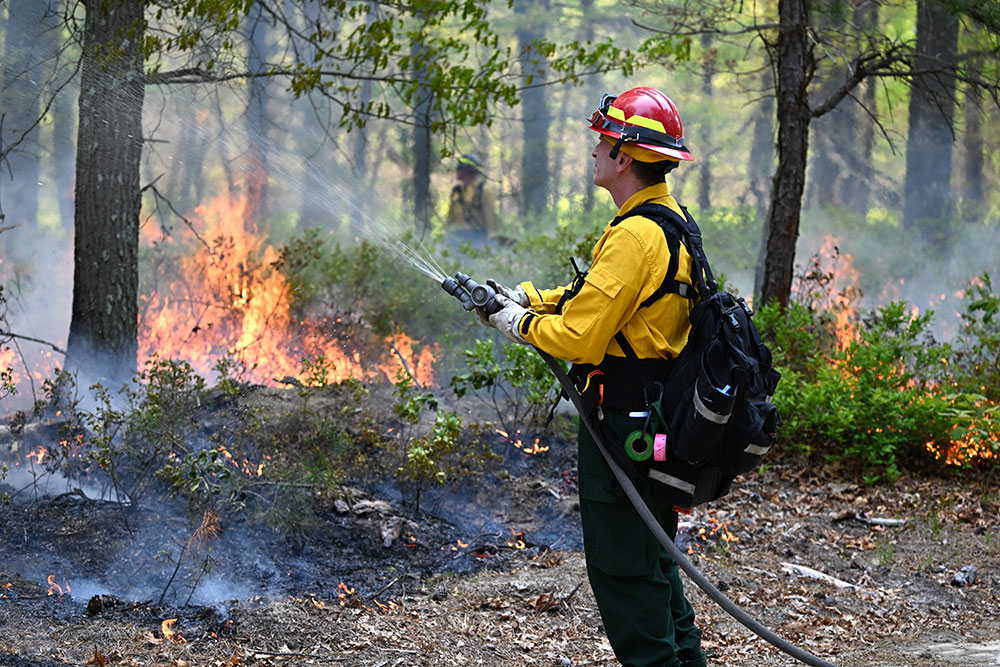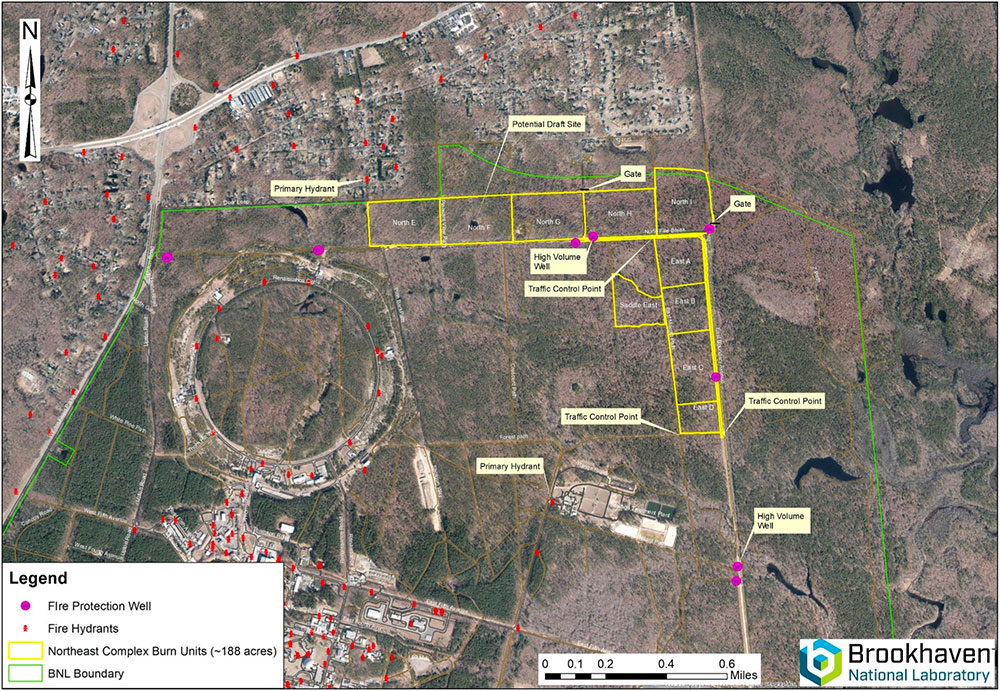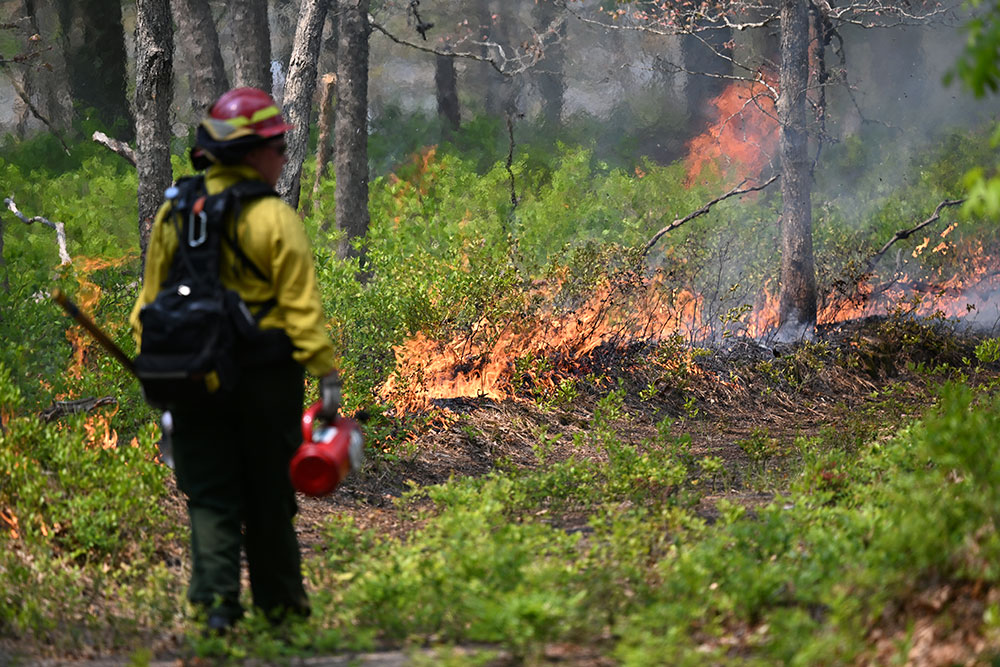Good Fires Prevent Bad Ones: Prescribed Burns at Brookhaven Lab
Prescribed fires burned 37 acres of land over two days to protect human communities and pine barrens ecosystems.
August 1, 2023
 enlarge
enlarge
Wildland firefighters conducted prescribed burns at Brookhaven National Lab twice in May 2023.
After watching the skies glow orange from the smoke of Canadian wildfires, many people living on the East Coast of the United States began weighing the consequences of climate change more heavily. The Earth is becoming hotter and drier, resulting in larger and more destructive wildfires. These threats to the climate and human health warrant long-term change that needs to be implemented systemically, but smaller initiatives on the local level can be executed to mitigate the loss and destruction caused by wildfires.
As a proactive measure to reduce the risk of wildfires in its local community, the U.S. Department of Energy’s Brookhaven National Laboratory conducts prescribed fires on its land, most recently in the northeastern corner of the Lab site on May 9 and May 24, 2023.
The main objective of a prescribed fire is to reduce fuels available for wildfire by burning organic material—vegetation, dead leaves, tree limbs, and other organic debris—under moderate conditions and in a systematic manner.
Safety & Environmental Motivations
Organic materials serve as fuel for wildfires, which is why Prescribed Fire Program Manager Kathy Schwager and her team work to remove them safely during prescribed burns at Brookhaven. Should there be a wildfire in the future, it will burn less intensely thanks to these fuel reduction efforts.
Brookhaven Lab lies within the Long Island Central Pine Barrens, one of only three Atlantic coastal pine barrens in the world. Pine barrens are fire-adapted ecosystems, meaning that they need fire to survive. The Long Island Central Pine Barrens is home to pitch pine trees, which are some of the most fire-adapted trees. In addition to withstanding both low- and high-intensity fire, pitch pine trees can also handle a lack of nutrients and droughty soils. These conditions are characteristic of pine barrens ecosystems.
“We live in a world that is carbon-based. Carbon things burn. Every living thing on this planet burns," Schwager said. "The Pine Barrens needs fire more frequently. Without fire, organic material builds up, creating conditions for less fire-adapted species to grow and outcompete the pitch pines. Without pines, we don’t have pine barrens anymore, and there are a lot of insect and wildlife species that rely on pine barrens.”
The competition from other tree species is not the only threat facing the pitch pine trees. The southern pine beetle, whose population is growing in Suffolk County, infests pine trees and impedes the flow of nutrients and water. These disruptions kill pine trees in a matter of months. Southern pine beetles used to primarily live in warm climates like the southeastern United States and Central America. Now, with Long Island winters becoming milder, the beetles can survive further north. To mitigate the loss of pitch pines due to the increased presence of southern pine beetle, it is important to promote the regeneration of the pitch pine. This can be accomplished, in part, by conducting prescribed burns.
 enlarge
enlarge
Map of burn units included in the burn plan. The 188 acres of land outlined in yellow are split into ten burn units, each consisting of between eight and 23 acres. Unit I was burned on May 9, 2023 and Saddle East Unit was burned on May 24, 2023.
Leading up to a Burn
Months of planning go into conducting a prescribed burn. Schwager begins with a prescribed burn plan—a comprehensive document outlining objectives, risks, safety precautions, emergency phone numbers, maps, and detailed plans for the day of the burn. This document also includes "the prescription," which specifies the range of weather and fuel conditions necessary for a burn. Upper and lower limits are established for temperature, wind speeds, relative humidity, and fuel conditions—just to name a few factors.
Once the plan is reviewed and approved, Schwager starts building her team with help from the New York State Department of Environmental Conservation (NYSDEC), the Central Pine Barrens Commission, Brookhaven’s Fire Rescue Group, and other federal, state, or local agencies.
“I need a minimum of ten people, each with qualifications specific to their role in the burn,” Schwager said. “They all have to be trained wildland firefighters to do prescribed fires, especially on federal property, and they are all qualified per National Wildfire Coordinating Group (NWCG) standards.” Brookhaven’s Fire Rescue Group plays a vital role in supplying these qualified crew members, as well as equipment for the prescribed burns.
With a crew on standby, Schwager starts watching the weather more closely, waiting for a day within the range of prescribed conditions. If a forecast is "in prescription", Schwager requests a spot weather forecast from the National Weather Service the afternoon before the planned burn. This is a very specific forecast for the exact areas that will be burned. If this forecast looks good, Schwager notifies the team that they are a “go” for the following day.
Burn Day
The morning of the burn, the team of wildland firefighters meet to review the Incident Action Plan (IAP) as part of pre-burn briefing.
“We go over why we are here, what we are doing, what our objectives are, hazards, everything that is in the IAP. This is part of the incident command system that we use during the prescribed burns,” Schwager explains, emphasizing the vitality of communication and understanding of responsibilities and safety.
“Accountability is so important. You need to be accountable for your people and their safety,” she emphasized.
Once the safety brief is complete and the humidity is less than 50%, the team lights a test fire on the downwind side of the burn unit. If this fire behaves as expected, the crew continues the burn.
Brookhaven’s prescribed burn area covers 188 acres of land split into ten units, each consisting of between eight and 23 acres. To ensure the safety of the crew and surrounding communities, only one unit is burned at a time. On May 9, 2023, the team burned the 23-acre Unit I. About two weeks later, the team burned the 14-acre Saddle East Unit on May 24, 2023.
 enlarge
enlarge
Prescribed fires are ignited along the fire line, a barrier of material that will not burn intensely. In the image above, the dirt path adjacent to the fire serves as the burn line.
The burn units are separated by fire lines or fire breaks—barriers that will not burn—keeping the fire contained to each unit.
“Most of our units have roads around them and that’s the fire line. Fire isn’t going to creep across,” Schwager explained.
For the units that are not separated by roads, the crew creates barriers. Mowing the vegetation and removing any debris with a leaf blower can also serve as a fire line. While a mowed fire line will not stop a fire, it will make the fire more controllable because there is less fuel to burn.
“Our fire lines are really, really good. It makes things a lot easier,” Schwager said, but cautioned that there are still ways for fires to escape the units. Wind can carry embers across the fire lines and start fires on other plots of land.
While no embers carried during the most recent prescribed burns, Schwager and her team always address and plan for the risk. “That’s what the engines are there for,” she noted while explaining some precautionary measures.
After the team finishes igniting the fires, they will put the ignition devices away and let whatever is burning continue to do so for about an hour. The team will then begin “mopping up”—extinguishing any residual fire—starting in the area of the test fire. Making sure that there is no fire high up in the trees is a priority at this point in the day, as this fire would be more likely to spread outside of burn units. If the team is unable to extinguish these fires through simple measures, they will take the trees down to do so.
By the end of the day, most of the fires are no longer active, but they may be smoking or smoldering.
“I will patrol a fire for a couple of days afterwards. I don’t call it out, ever, that same day. I’ll be out there doing what we call ‘mop up’ for a couple of days afterwards to make sure every bit of smoke is gone,” Schwager explained. “I wait until I don’t see any smoke for at least 24 hours before I officially call it out.”
Nature can also help extinguish the fires. Since the Lab is located in a humid, coastal region, humidity often reaches nearly 100% overnight. This humidity prevents the perpetuation of extreme fire conditions, making it easier to control and put out the prescribed fires.
Brookhaven Lab’s History of Fire, Prescribed and Not
“The first prescribed burn was October of 2004. The fire academy is typically held in October,” Schwager explained, referring to the New York Wildfire and Incident Management Academy (NYWIMA). “We did about eight acres during the academy. Burning in October is not the best time though, so they were more training burns.”
While there were small and low-intensity fires on Brookhaven’s land, this was the first large and high-intensity fire the Lab had experienced since the 1930s.
“I came on in 2010 and during the academy in 2011 we did another 16 acres,” Schwager said.
Months after the prescribed burns of 2011, forests on the Lab’s property and in the surrounding communities were devastated by a 2012 wildfire, dubbed the “Crescent Bow” fire. During this April fire, nearly 300 acres burned in under 40 minutes, succeeded by another 700 acres offsite.
“That fire scared people,” Schwager recounted. “People were evacuated, structures were destroyed, the Long Island Expressway was shut down. It was very impactful.” In a way, this fire helped the public understand what prescribed fires are intended to prevent.
Since the Crescent Bow fire, three prescribed burns were conducted at Brookhaven Lab in 2017, one in 2018, one in 2022, and the two this year so far.
As for the burns done last month, all measurable objectives were met.
“They were carried out safely, which is the most important thing,” Schwager noted. “If we get the right conditions as the summer goes on it is a possibility to do more burns.”
The prescribed burns program is still evolving. Schwager and her team hope to conduct prescribed burns more consistently and on a much greater scale throughout the Long Island Central Pine Barrens to preserve the ecosystem.
“We’re trying to protect communities,” Schwager said, “and we’re trying to restore pine barrens ecosystems.”
Brookhaven National Laboratory is supported by the Office of Science of the U.S. Department of Energy. The Office of Science is the single largest supporter of basic research in the physical sciences in the United States and is working to address some of the most pressing challenges of our time. For more information, visit science.energy.gov.
Follow @BrookhavenLab on social media. Find us on Instagram, LinkedIn, Twitter, and Facebook.
2023-21363 | INT/EXT | Newsroom









